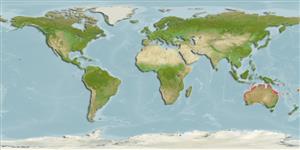Environment: milieu / climate zone / depth range / distribution range
Ecologia
marino; salmastro associati a barriera corallina; distribuzione batimetrica 0 - 10 m (Ref. 90102). Subtropical; 11°S - 35°S
Western Central Pacific: Indonesia to northern Australia (including Western Australia) and New Guinea.
Length at first maturity / Size / Peso / Age
Maturity: Lm 4.7, range 5 - 4.9 cm
Max length : 12.0 cm TL maschio/sesso non determinato; (Ref. 9710)
Spine dorsali (totale): 8; Raggi dorsali molli (totale): 9-10; Spine anali 2; Raggi anali molli: 9 - 10; Vertebre: 24. Adults have two separate dorsal fins, and a brown translucent body with a series of black spots along the lateral line (Ref. 33616). Greatest depth of body 2.1-2.6 in SL (Ref. 90102).
Inhabit inshore reefs and estuaries (Ref. 9710). Occur in groups in weedy areas (Ref. 9710). Nocturnal species (Ref. 7300).
Are mouthbrooders. The male is usually responsible for incubating the eggs (Ref. 240). Males brood from 50 to 230 fertilised eggs for about two weeks until hatching (Ref. 35252). Distinct pairing during courtship and spawning (Ref. 205).
Paxton, J.R., D.F. Hoese, G.R. Allen and J.E. Hanley, 1989. Pisces. Petromyzontidae to Carangidae. Zoological Catalogue of Australia, Vol. 7. Australian Government Publishing Service, Canberra, 665 p. (Ref. 7300)
IUCN Red List Status (Ref. 130435)
Threat to humans
Harmless
Human uses
Informazioni ulteriori
BibliografiaAcquacolturaProfilo di acquacolturaVarietàGeneticaElectrophoresesEreditarietàMalattieElaborazioneNutrientsMass conversion
CollaboratoriImmaginiStamps, Coins Misc.SuoniCiguateraVelocitàModalità di nuotoArea branchialeOtolithsCervelliVista
Strumenti
Special reports
Download XML
Fonti Internet
Estimates based on models
Preferred temperature (Ref.
123201): 22.3 - 28.6, mean 26.7 °C (based on 416 cells).
Phylogenetic diversity index (Ref.
82804): PD
50 = 0.5000 [Uniqueness, from 0.5 = low to 2.0 = high].
Bayesian length-weight: a=0.01288 (0.00551 - 0.03009), b=3.10 (2.92 - 3.28), in cm total length, based on LWR estimates for this Genus-body shape (Ref.
93245).
Trophic level (Ref.
69278): 3.5 ±0.50 se; based on food items.
Resilienza (Ref.
120179): Basso, tempo minimo di raddoppiamento della popolazione 4.5 - 14 anni (Fec = 50).
Fishing Vulnerability (Ref.
59153): Low vulnerability (10 of 100).
Nutrients (Ref.
124155): Calcium = 81.3 [36.1, 179.3] mg/100g; Iron = 0.868 [0.442, 1.734] mg/100g; Protein = 19.7 [18.4, 20.9] %; Omega3 = 0.187 [0.091, 0.383] g/100g; Selenium = 10.9 [4.2, 24.7] μg/100g; VitaminA = 35.6 [8.3, 164.3] μg/100g; Zinc = 1.28 [0.73, 2.06] mg/100g (wet weight);
